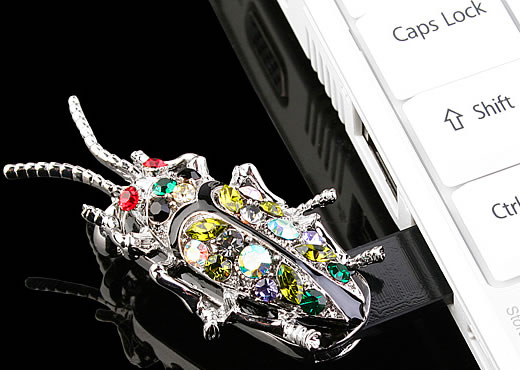My post in a nutshell:
 |
| http://www.geekalerts.com/usb-bug/ |
 *Don't get anything that is measured in MB, it's too small and a waste of money! Technology is developing so quickly now that there are 512 MB drives for $15, next to a 2 GB drive for $7. MB is smaller, go for the GB.
*Don't get anything that is measured in MB, it's too small and a waste of money! Technology is developing so quickly now that there are 512 MB drives for $15, next to a 2 GB drive for $7. MB is smaller, go for the GB.*Lids are made to be Lost--if it has a cap or lid, it's probably going to be missing within 6 months (if you are lucky).
*If this is the first time you are shopping for one, go for a 4 or 2 GB and spend $10 to $15
I recommend a 4 GB for the occasional user, and a 16 GB for the power user if you will be making SmartBoard presentations, music or video, and photos in your CPS. You can get a 4 GB for $10 at Staples, or a 2 GB for $12. No, I didn't get that backwards--the larger 4 GB is cheaper, you just have to shop around. Either one would work fine for our purposes in the Master Teacher classes. But for data storage, the bigger the better, so if you are able to get a larger one, I strongly recommend it. If it's your first, keep it around $10 and see if you are 1) going to use it, and 2) not going to loose it. Do you play with graphics or music? If so, spring for a bigger drive. If not, keep it simple and cheap to see if it's right for you.
Why do we need a Thumb Drive?
We live in a digital age, and we are teaching digital learners. We need to learn to engage the students in familiar ways--and integrating technology is a great way to do this. Also--we move around. We dont teach from home, where we get some of our best ideas. As professionals, we are often moving files between home and work, or just from room to room within the school or other job site. We need a way to carry files with us that is stable, physically space efficient, but able to hold a lot of information without filling up. A "thumb" drive, also called a flash or jump drive, can travel wherever you go, and can hold lots of information. The name thumb drive suggests its about as big as a thumb, although they are getting smaller every time I buy one. They come in many sizes and shapes, from cute jewelry to key shaped. They all plug in to a USB port on a computer.
The main things to consider are the storage capacity, and the speed. Capacity, or how much information can be held, is measured in Bytes.
byte < kilobyte < Megabyte < Gigabyte < Terabyte
More Info: http://www.liutilities.com/articles/how-to-choose-usb-flash-drive/
More about speed another time, I think I'm getting a little to deep in the Nerd Department.

No comments:
Post a Comment